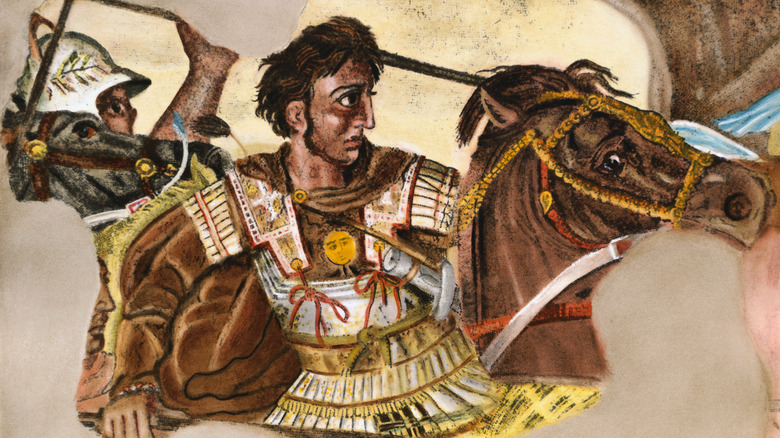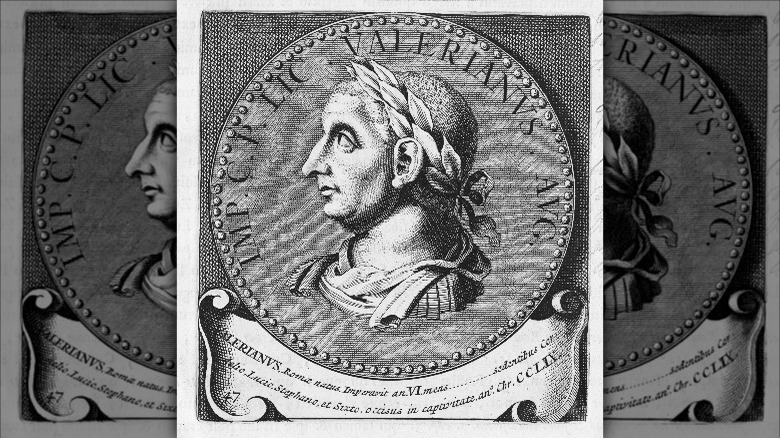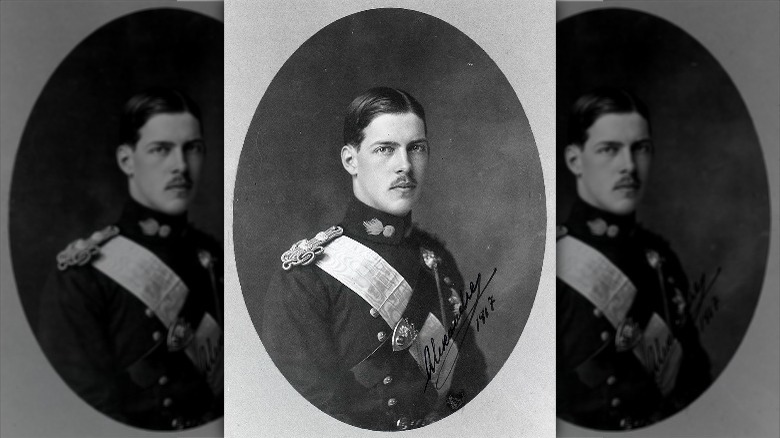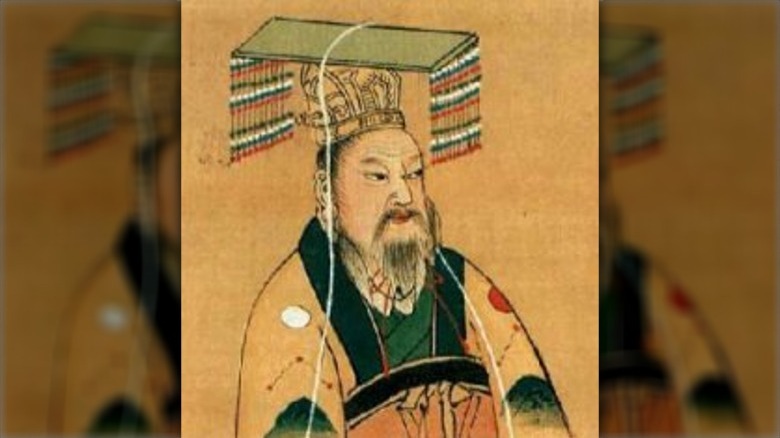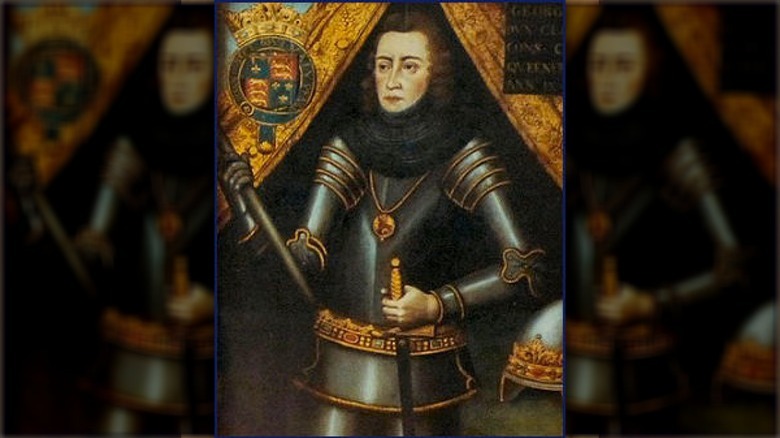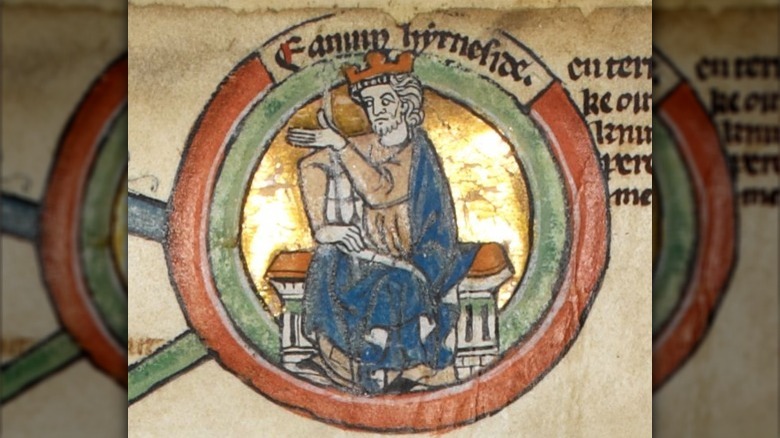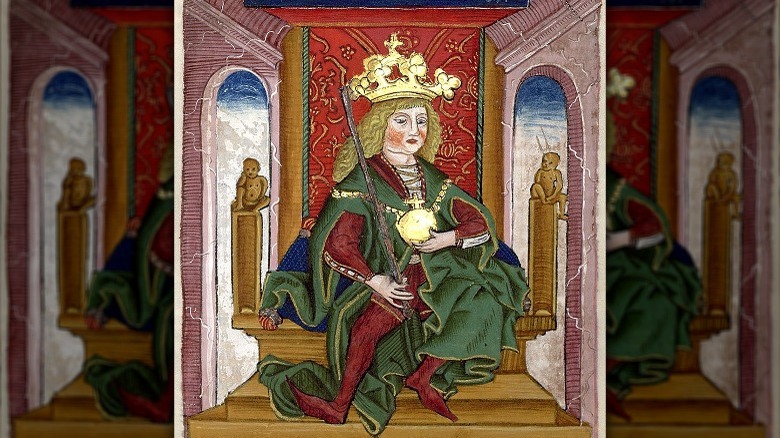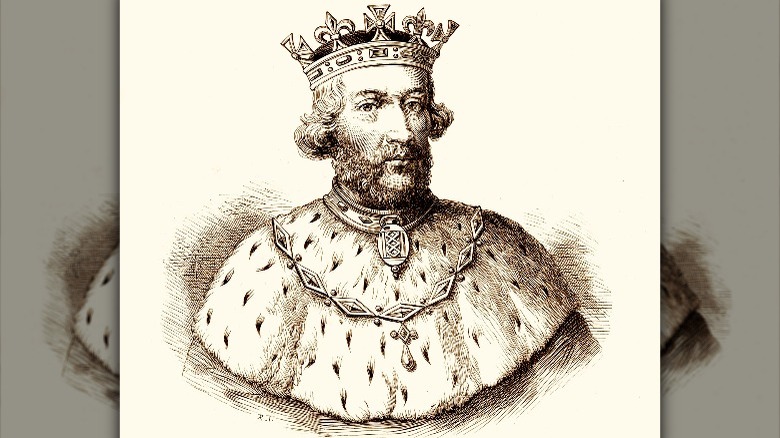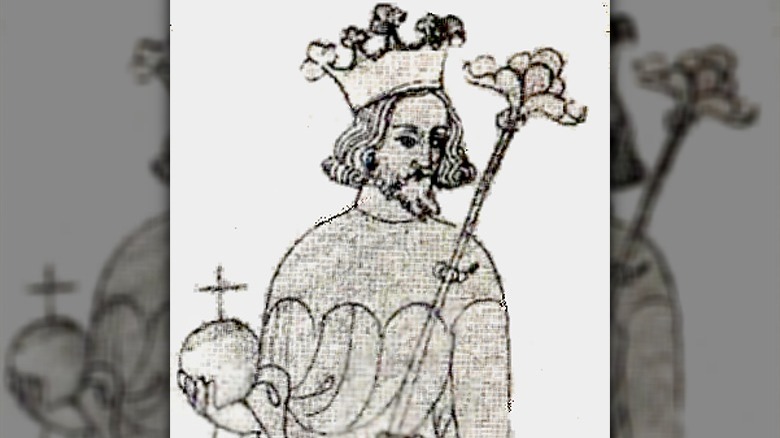Royals Who Died In Bizarre Ways
The topic of royalty is something that's endlessly fascinating to plenty of people, whether the royals in question are those from way back in history or those who currently possess a title. The stories about their lives can vary greatly from each other, ranging from the tragic to the heroic, but death is always a constant, no matter what the other details may be. That said, more than a few stories of royal deaths are pretty hard to believe, or just simply bizarre.
In some cases, the circumstances and nature of royal deaths can be more notable than anything that said nobles did in their lives — particularly in the cases of those from further back in history, with ancient and medieval rulers probably not being something that most people are fully familiar with. But even if the royals themselves aren't exactly household names, the stories of their deaths will be sure to stick with you.
Alexander the Great
The stories and glory of Alexander the Great aren't exactly mysteries. The Macedonian ruler was one of the most prominent leaders of the ancient world, expanding his territory by crumbling the Persian Empire, heading east toward India and south into Egypt. He was viewed in such high esteem that fantastical stories and legends even began spreading before his death, but the truth of his actual death is something of a mystery.
In 323 B.C., at the age of 32, he suddenly and inexplicably fell ill, experiencing fevers, intense pain, and periods of paralysis. He died just under two weeks after the onset of those symptoms, and to this day, no one knows the cause. Rumors surfaced in the years following his death that he'd been assassinated, poisoned by enemies or political rivals, and historians have more recently pondered the possibility that he died from a combination of malaria and old battle wounds.
But there's another strange factor to consider: The body of Alexander the Great didn't decompose for six days after he was officially declared dead. Historical records saw this as proof of his godhood, but modern theories posit that he wasn't dead at all. Rather, he might have contracted an autoimmune disorder that causes not only fever and pain, but also progressive paralysis. Doctors at the time based death on the presence of breath, but full paralysis could have rendered his breathing weak enough to be undetectable. In other words, he might have been incorrectly declared dead, which would explain the delayed decomposition.
Princess Grace of Monaco
American actress Grace Kelly basically lived out the dream that many people have of becoming royalty, owing to her marriage to Prince Rainier III of Monaco in 1956. But Kelly's tragic death has raised some strange questions.
In September 1982, Kelly was driving with her 17-year-old daughter when she lost control of the vehicle, which fell over the side of a cliff. She experienced two massive strokes during the accident, resulting in a brain hemorrhage. Declared brain dead in the hospital, her family decided to remove her from life support the next day.
As straightforward as that sounds, many people have questioned what exactly happened. For one, Kelly openly disliked driving, leading to open inquiries as to why she'd decided to get behind the wheel at all that day. On top of that, some have even speculated that Kelly's daughter was the one actually driving — though she has actively denied that rumor — or that the two were in the middle of a heated argument. And then, there's the road where the car fell off the cliff. Despite featuring a sharp turn, investigations found no skid marks, and witnesses saw no brake lights on the car — indications that the vehicle was accelerating toward the turn, not braking. Kelly's daughter has stated that she tried to put the car into park and pulled the handbrake, but to no avail. With engineers finding nothing mechanically wrong with the car, she has since wondered if her mother confused the brake with the accelerator, though she's not entirely sure.
Emperor Valerian
Publius Lucinius Valerianus — better known as Emperor Valerian — ruled Rome from only A.D. 253 to A.D. 260, a short stint in the midst of one of the most notoriously unstable points of the timeline of the Roman Empire. Valerian hoped to bring peace and order back to the empire, but ultimately, he would be better known for his failures.
Notably, in A.D. 260, he arranged to meet with Persian emperor Shapur I, only to learn he'd been led into a trap and forced into a life of captivity in Persia. There, he was forced to suffer numerous indignities, such as being dragged around in chains and literally used as a footstool for Shapur, but none more so than his death.
Generally, there are two different stories of his death, though both are brutal and bizarre. One version of the story says that he was flayed alive, his skin displayed as a gruesome warning; Roman author Lactantius wrote, "He was flayed, and his skin, stripped from the flesh, was dyed with vermilion, and placed in the temple of the gods of the barbarians" (via Ancient Origins). The other version claims that rather than being flayed, he was forced to drink molten gold — a process that probably ruptured organs, cooked muscle, and choked him. Both are certainly brutal ways to go, although other artistic renditions from the time also depict Valerian being treated relatively well by Shapur, so some mystery still remains.
King Alexander I of Greece
In the midst of World War I, Greece's monarchy was in flux, and the stability of the time period certainly wasn't helped when King Alexander I was killed by a monkey.
Alexander took power in Greece in 1917 — the result of messed-up World War I politics that forced his father and brother (the crown prince) into exile — but only a few years later, in October 1920, he was out on a simple walk with his dog near the Tatoi estate in Athens. Suddenly, a monkey appeared and began to attack his dog, but as Alexander stepped in to try and save his pet, another monkey jumped out at him and managed to bite him several times. The monkeys were chased away in short order (apparently, they were actually owned by someone working at the estate), and Alexander tended to his wounds, thinking that they weren't particularly serious.
Unfortunately, that was far from the truth. In less than a day, the bites were badly infected, and they only got worse as the days and weeks passed. Doctors knew that the situation was grave, but they weren't willing to commit to any particular treatment, mostly due to the fact that their best course of action was amputation. They continued to delay and debate, unwilling to take drastic action, and during that time, Alexander's condition only worsened as the infection spread; he ultimately died just over three weeks later, on October 25.
Shi Huangdi
Originally born as Zhao Zheng, the man who would eventually take on the title of Shi Huangdi — literally "first emperor" — is most known to history for being the first leader of a unified China. Starting as the ruler of the Qin state, he managed to annex all of his neighbors, officially creating the Chinese empire and Qin dynasty in 221 B.C., though both his empire and dynasty would technically only survive a few years beyond his death.
As emperor, Huangdi had a mixed record, but he also showed an interest in magic. He even went so far as to travel around East Asia and bring magicians to his court, searching for those with a talent for alchemy, especially where immortality was involved.
That particular interest only deepened as time went on, primarily because of multiple assassination attempts, some of which were nearly successful. He took precautions as a result, keeping his current location secret and commissioning a grand tomb for himself (famously known as the Terracotta Army), but he also made more frequent trips in his search for a rumored "Island of the Immortals" or magical herbs that could grant him immortality. That search also led him to try various elixirs made of ingredients now known to be poisonous, such as mercury. It's believed that Huangdi ironically died after ingesting one of his supposed immortality elixirs while on a trip, and his retinue had to hide the smell of his decaying body with barrels of fish while returning to the palace.
George Plantagenet, Duke of Clarence
The history of the War of the Roses is complicated, sending England's royal family spinning in the 15th century. But for now, it suffices to say that George Plantagenet was the younger brother of Edward IV, the first king from the house of York. After being made Duke of Clarence, Plantagenet was discovered conspiring against the king.
Despite eventually reconciling with his brother, in 1477, he illegally tried and executed a woman for supposedly poisoning his wife — a power he didn't technically have. At the same time, Edward once again had reason to believe his brother was conspiring against him, and in 1478, Plantagenet was arrested and tried for treason. After being found guilty, he was sentenced to death.
And that's where the story became a rumor. Plantagenet's death was scheduled privately within the Tower of London — likely a result of his own royal position, as well as Edward's desire to keep as much of the strife out of the public eye as possible. Supposedly, he was drowned in a vat of sweet malmsey wine, though any further details than that are purely speculative. Some believe that Plantagenet chose the method of execution himself, potentially due to drowning being a recognized method of execution at the time, or as a way to mock his brother's drinking habits. Alternatively, it might have been chosen for the reason that drowning didn't technically spill any royal blood, something the family might have wanted to avoid.
King Edmund Ironside
Throughout history, the matter of succession within the English monarchy has often been a rather messy business, and that was certainly true in the case of King Edmund II, popularly known as "Ironside." Edmund is largely known for mounting a resistance against the Danish king Canute in 1016 — a conflict he lost, though he retained rule over the region of Wessex and earned his nickname in the process. But just seven months after a treaty was signed that divided England between him and Canute, Edmund was dead. Some sources cite natural causes, but many others point to assassination. The exact reports on the method of assassination vary, with some looking to poison, though the most popular stories place the murder in the bathroom — specifically, on the toilet.
The stories only continue to diverge from there. Some versions claim that the assassin hid underneath the floor — directly below the hole that the king would eventually use to relieve himself — and stabbed when the opportunity presented itself. Another rumor posits that a complex booby trap involving a crossbow was somehow set up, going off when the king arrived in the bathroom. Eadric Streona — a former official under Edmund who betrayed him to side with Canute — was named by those reports as the assassin in question, though he was actually killed by Canute just a year later, out of fear of further disloyalty and treason.
King Béla I of Hungary
Eleventh-century Hungarian history might not be a familiar topic to most people, and so the short reign of King Béla I isn't one that's talked about terribly often. In short, much of his life was marked by questions of royal succession. His father was a prince — the nephew of the Hungarian king — who was passed over when it came to ruling, then subsequently blinded as a consequence for revolting.
Béla and his brothers fled the country but were asked to return when the nobility chose to depose their new king; he was named heir after his brother and eventually became king in 1060. But when his nephew Salomon was suddenly named as heir instead — a breach of tradition — a complicated political mess set in that even had the Holy Roman Empire meddling in Hungarian affairs.
But as the Holy Roman Empire was making military advances on Hungary in 1063, Béla suddenly died. Not to sickness or war, but as a result of his throne somehow collapsing beneath him while in the city of Dömös. The wounds sustained in that incident were serious enough that they left him barely conscious; nonetheless, his supporters carried him to Kinizsa Creek, hoping he could still carry out diplomatic discussions. He died of his injuries at that creek, and questions remain as to whether the collapsing throne was just a bizarre accident or a successful assassination.
King Edward II
King Edward II, ruler of England from 1307 to 1327, was far from a popular figure. The medieval king is mostly known for being a particularly ineffective ruler, losing territory that his father had gained, enraging the nobility by showing political favoritism to those he was personally close with, and generally refusing to listen to the demands of those he led. Ultimately, his downfall came at the hands of his own wife, Isabella, who fled the country and returned with a small — but incredibly angry — invasion force filled with nobles who wanted to see Edward deposed.
By 1326, Isabella was successful and her son was set to be installed as the next king, while Edward was arrested and imprisoned in Berkeley Castle. Within the following year, he was forced to abdicate as Edward III was crowned as king, and in September 1327, he died. Technically, the records end with his imprisonment and abdication, and there's little official writing about what happened from then on. But as it's typically understood, Edward was most likely executed in Berkeley Castle, and the most recognized version of that story is that the method of execution was particularly strange and gruesome: a scorching hot metal poker forced up his anus.
Further details aren't exactly forthcoming, but that's led to far more recent speculation that the rumors of Edward's death were entirely fabricated and that he was alive at least as late as 1330, though this view has been met with a fair bit of criticism.
Sigurd Eysteinsson
There are plenty of popular myths about Vikings everyone believes, but the story of Sigurd Eysteinsson — Norse earl of the island of Orkney and an instrumental figure in the Viking conquest of Scotland in the late 800s — is an especially strange story. Despite his military successes and prowess, it's his death that's especially memorable. And it didn't even come on the battlefield.
As the story goes, Eysteinsson came into conflict with a leader from the Scottish mainland, Máel Brigte the Bucktoothed. The two decided to settle their differences in battle, agreeing to each bring their own army made up of only 40 men. Though the fight was meant to be an honorable one, Eysteinsson had no intention of following the rules, reportedly having two men mount each horse rather than one, essentially trying to create the illusion that he'd brought a force of 40 men when, in reality, he'd brought double that amount. Perhaps predictably, his force won the battle easily, and Brigte's head was chopped off, promptly tied to Eysteinsson's saddle as a trophy.
But the "Bucktoothed" part of Brigte's name was there for good reason. As the Vikings rode home, one of Brigte's teeth sunk into Eysteinsson's leg as it bounced against his horse. Eysteinsson apparently thought little of the wound as he continued to ride, but it became infected shortly after. He died of the infection before even returning home, killed by the severed head of his slain enemy.
King John of Bohemia
While many bizarre deaths of royals seem to be associated with some level of perceived foolishness or incompetence, the strange death of King John of Bohemia is simultaneously viewed as a noble one.
John was a member of the Luxembourg dynasty who had long ruled the Holy Roman Empire, and after an education in France, he was crowned the king of Bohemia in 1311. A capable but unpopular leader, he spent quite a bit of his time taking part in military conquests across the continent, cementing his image as an ideal knight of legend, though in one of those campaigns, he contracted a condition that ultimately left him blind, earning him a new nickname: John the Blind.
As the Hundred Years' War raged through Europe, John sided with the French king and would ultimately leave his mark on history. During the 1346 Battle of Crecy, the French troops and their allies found themselves fighting a desperate, losing battle. John was informed of the state of the fight, but despite being told he should retreat, the blind king wanted to ride into battle. He had his men tie their horses to his own, guiding him onto the battlefield and to his inevitable death. As he explained it: "Far be it that the King of Bohemia should run away. Instead, take me to the place where the noise of the battle is the loudest ... Just take good care of my son" (via Ancient Origins).

